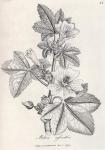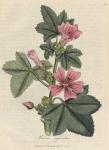
 Also see 053. Althaea officinalis. Marsh-mallow.
Also see 053. Althaea officinalis. Marsh-mallow.
Synonyma. Malva. Pharm. Lond. & Edinb.
Malva sylvestris folio sinuato. Bauh. Pin. p. 314.
Malva vulgaris flore majore, folio sinuato. J. Bauh. Hist. vol. ii. p. 949.
Malva vulgaris. Park. Theat. p. 299. Raii Hist. p. 599. Synop. p. 251.
Malva caule erecto, foliis lobatis, lobis serratis, quinis & septenis. Hal. Stirp. Helv. n. 1069.
Malva sylvestris. Gerard. Emac. 930. Withering. Bot. Arrang. p. 738. Curt. Flor. Lond.
Class Monadelphia. Ord. Polyandria. Lin. Gen. Plant. 841.
Ess. Gen. Ch. Cal. duplex; exterior 3-phyllus. Arilli plurimi, monospermi.
Spec. Char. M. caule erecto herbaceo, fol. septemlobatis acutis, pedunculis petiolisque pilosis.
The root is perennial, thick, long, whitish, and furnished with many strong fibres: the stem is erect, round, strong, hairy, branched, and rises from one to three feet in height: the leaves are numerous, roundish, divided into five or seven lobes, unequally serrated or notched at the edges, and stand upon long round hairy footstalks: the two stipuls are placed at the base of each footstalk: the flowers are large, consisting of five petals, which are inversely heartshaped, sinuated at the apex, and of a purple colour, painted with veins of a deeper hue, and stand upon slender peduncles, which proceed from the bottom of the leaf-stalks: the calyx is double, the outer is composed of three, and the inner of five oval pointed hairy segments: the stamina are numerous, united at the base in a cylindrical shape, above separate, bending downwards, and furnished with kidney-shaped anthers: the germen is roundish: the style cylindrical, short, and furnished with many filiform stigmata: the seeds are numerous, of a kidney-shape, and covered with a coat, or arillus, which opens inwardly. It is common under hedges and in waste grounds, and flowers from June till September.
This plant ["Malva quasi melva quod alvum molliat, ut inquit Festus, secundum tritum ilium Scholae Salern, versiculum, dixerunt malvam veteres quia molliat alvum. Gr. (greek), ob eandem rationem. Utrumque etymon improbac C. Hoffman nec tamen meliora substituit." Tournf.] has a strong affinity to the Althaea both in a botanical and in a medicinal respect; but the roots of the malva are useless, while those of althaea are of more efficacy than any other part of the plant. Accordingly we find that only the leaves and the flowers of the former are directed by the college for pharmaceutical purposes. Formerly when horticulture was little understood, and of course the choice of esculent vegetables extremely limited, the maöva was admitted amongst the more common articles of diet; [Me pascunt olivae, Me cichorea levesque malvae. Hor, l. I. Od. 31. Exoneraturas ventrem mihi villica malvas Attulit, & varias, quas habet hortus, opes. Martial. The laxative quality of this plant is also mentioned by Cicero. Epistol. lib. 7. epist. 26.] and we are told that the Chinese still eat the leaves of mallow either raw as sallad, or boiled as spinage. [Melanges interessans et curieux. Tom. 4. p. 28.]
Respecting the medicinal qualities of this plant, little remains to be said after the account we have given of Althaea, as the leaves afford a similar glutinous juice, which is fitted to answer the same purposes as those of marsh-mallow, and are therefore principally used in fomentations, cataplasms, and emollient enemas; but the internal use of these leaves seems to be wholly superseded by the radix althaeae. ["Althaeae in omnibus supra dictis efficacior radix." Plin. Nat. Hist. vol. 2. p. 662.]

